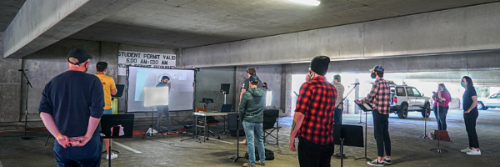The School of Music and Dance and Arts Alive SDSU Explore Binational Vocal Traditions

The SDSU Chamber Choir presents “El Puente,” an online, pre-recorded concert produced by the School of Music and Dance that is amplifying the conversation about Mexican and U.S. traditions and includes a panel discussion by Arts Alive SDSU.
The panel discussion is on May 6 at 4 p.m., and the concert premieres May 7 at noon.
The panel discussion on May 6 is part of the Arts Alive SDSU Discovery Series which positions the arts alongside the humanities and sciences to encourage the development of new ways to understand the world. It will feature faculty members from the Department of Chicana and Chicano Studies and the School of Music and Dance, as well as Director of Coro Acardenchado and Guest Artist in Residence Juan Pablo Villa, and Director of Choirs David Arontes from Conservatorio Nacional de Música in Mexico.
Chair of Arts Alive SDSU Dr. Eric Smigel said, “It will be an extraordinary opportunity for students to explore binational traditions of vocal and choral music not only across academic disciplines, but also across international borders.”
“By focusing on the relationship between choral music in Mexico and the Southwestern United States, “El Puente de la Canción” will entreat us to listen more carefully to each other’s songs and invite all our voices to sound together,” Smigel said.
The “El Puente” choral concert is on May 7. According to Dr. Arian Khaefi, director of choral studies, “audiences will have a deeply impacting experience listening to an endangered vocal artform performed by students who’ve spent the past semester engaging with the last 600 years of Mexico’s socio-political and artistic culture.”
SDSU student and performance art major Diego Leon is a member of the choir and has been a cultural advisor for the project. “My experience as a Latinx person and a former student in the National Conservatory of Mexico, as well as my fluency in Spanish, has come in handy in the process of bringing this project to life,” Leon said.
Leon hopes the project can connect North American and Latin cultures. “I hope that American audiences can find beauty in a musical tradition that is foreign to their own and that this helps to humanize and expand people’s understanding of Mexican culture. I also hope that Latinx audiences can identify with and feel proud of our shared musical heritage,” he said.
Khaefi has an anecdote to explain what he hopes audiences will take away from this production: “The barbed thorn, or cardenche, of a cactus plant causes immense pain when you try to remove it. These pieces we have been working on this semester, Cardenche songs, derive their name from this thorn. These songs, which are sung in rural areas, typically in three-voice harmony, are ‘pure emotion’ as our artist in residence Juan Pablo Villa has noted in his rehearsals with us.”
“We must experience pain as we draw out the thorn. We must experience pain as we draw out the song. The themes of loneliness, isolation, loss, and estrangement are all present in these songs. Our work has been to experience these pains, to draw them out, to travel through the experience empty on the other side,” Khaefi said.
Click for information on the panel and concert and learn more about the School of Music and Dance on their website.
The content within this article has been edited by Lizbeth Persons.
